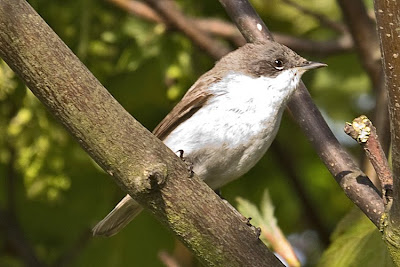Walking round the Paddock today, in that horrible NE wind, I didn't really expect to find anything surprising and I wasn't disappointed. There were quite a few Common Whitethroats singing, and in the central scrub a Lesser Whitethroat was rattling away.
 I always find Lesser Whitethroats difficult birds to photograph. They spend most of their time buried in the bushes, only occasionally showing themselves. I wasn't that surprised when I looked at the bird sitting out near the song of the Lesser Whitethroat to find it was a Chaffinch. They are plentiful around here and often sit at the top of the trees to sing their song.
I always find Lesser Whitethroats difficult birds to photograph. They spend most of their time buried in the bushes, only occasionally showing themselves. I wasn't that surprised when I looked at the bird sitting out near the song of the Lesser Whitethroat to find it was a Chaffinch. They are plentiful around here and often sit at the top of the trees to sing their song. The rattle was still going near by and from the other side of the tree I could see (and manage a blurred photo of) the Lesser Whitethroat. Perhaps this one would be more obliging.
The rattle was still going near by and from the other side of the tree I could see (and manage a blurred photo of) the Lesser Whitethroat. Perhaps this one would be more obliging. Even in the twigs with few leaves it was still difficult to manoeuvre a position where the bird was in the open.
Even in the twigs with few leaves it was still difficult to manoeuvre a position where the bird was in the open.You can almost hear the energetic song, first a little warble, not unlike a Common Whitethroat and then concluding with a rather undistinguished rattle that has been compared to a Cirl Bunting. It is strange that when you find these birds in eastern France, or further east in Europe, the starting warble is the predominant element of the song and the rattle either minimal or even non-existent.
 There was a nearby Common Whitethroat and I had the impression that the two birds were singing almost in tandem, as if each song spurred on the other. The darkish mask distinguishes the lesser from the common.
There was a nearby Common Whitethroat and I had the impression that the two birds were singing almost in tandem, as if each song spurred on the other. The darkish mask distinguishes the lesser from the common. I did manage a few photos as it worked it's way through the bush I was sitting by. Of course with the thistles, stinging nettles and plenty of reminders that the ground is grazed by horses, it wasn't the most comfortable seat in the world.
I did manage a few photos as it worked it's way through the bush I was sitting by. Of course with the thistles, stinging nettles and plenty of reminders that the ground is grazed by horses, it wasn't the most comfortable seat in the world. I hope it performs as well next time I'm there, hopefully when there isn't a near gale force wind. The name Lesser Whitethroat was given to Sylvia curraca in 1787, by John Latham, a physician from Dartford who also discovered the Dartford Warbler. AT the time, and until recently, it was assumed that the two Whitethroat species were their closest relatives, but in fact the Lesser Whitethroat is more closely related to some of the Sylvia Warblers from the Mediterranean, Africa and Arabia, such as the Orphean Warbler and Yemen Warbler. This group is variable, but all show the contrasting dark mask,
I hope it performs as well next time I'm there, hopefully when there isn't a near gale force wind. The name Lesser Whitethroat was given to Sylvia curraca in 1787, by John Latham, a physician from Dartford who also discovered the Dartford Warbler. AT the time, and until recently, it was assumed that the two Whitethroat species were their closest relatives, but in fact the Lesser Whitethroat is more closely related to some of the Sylvia Warblers from the Mediterranean, Africa and Arabia, such as the Orphean Warbler and Yemen Warbler. This group is variable, but all show the contrasting dark mask,

1 comment:
Well done Tony, I have never been able to photograph a lesser whitethroat, you did well.
Post a Comment